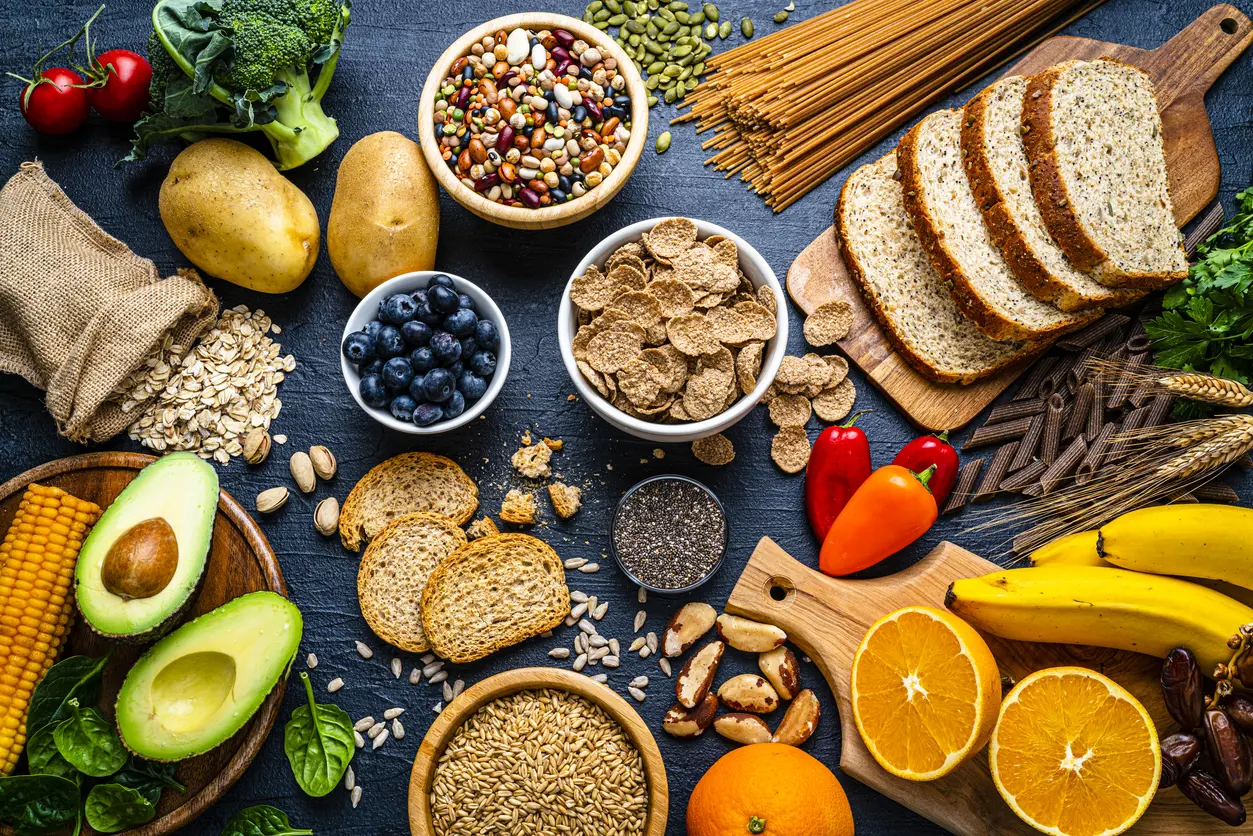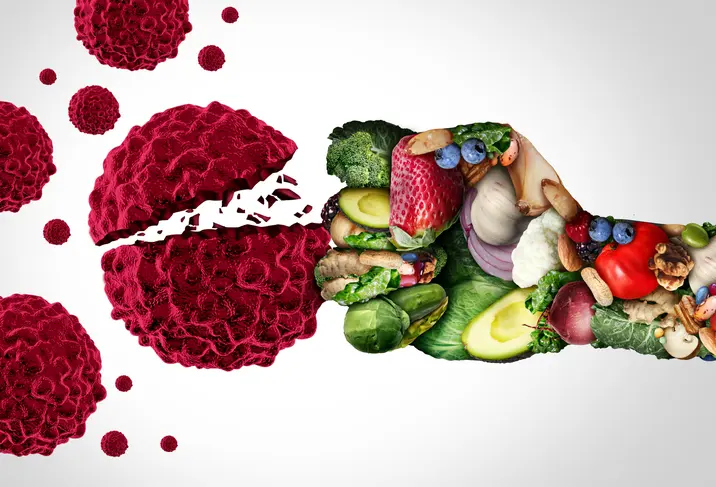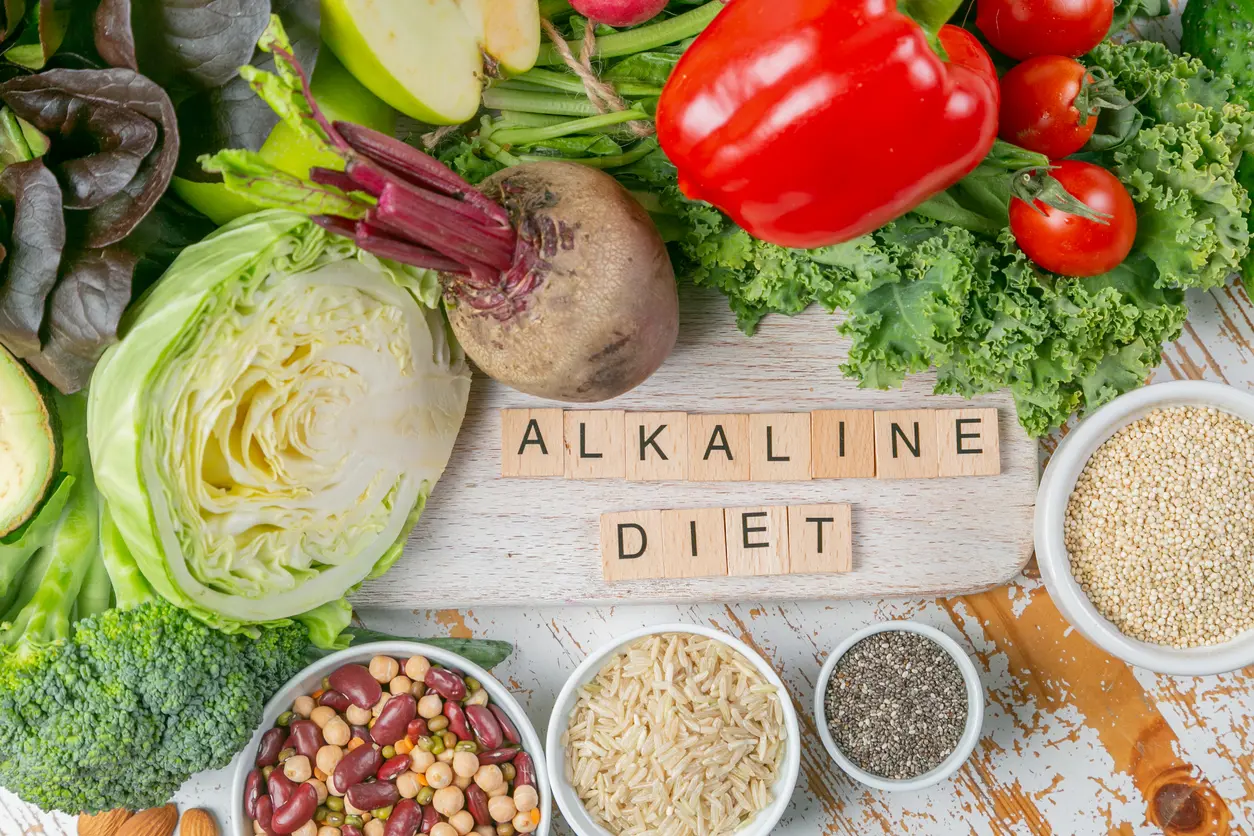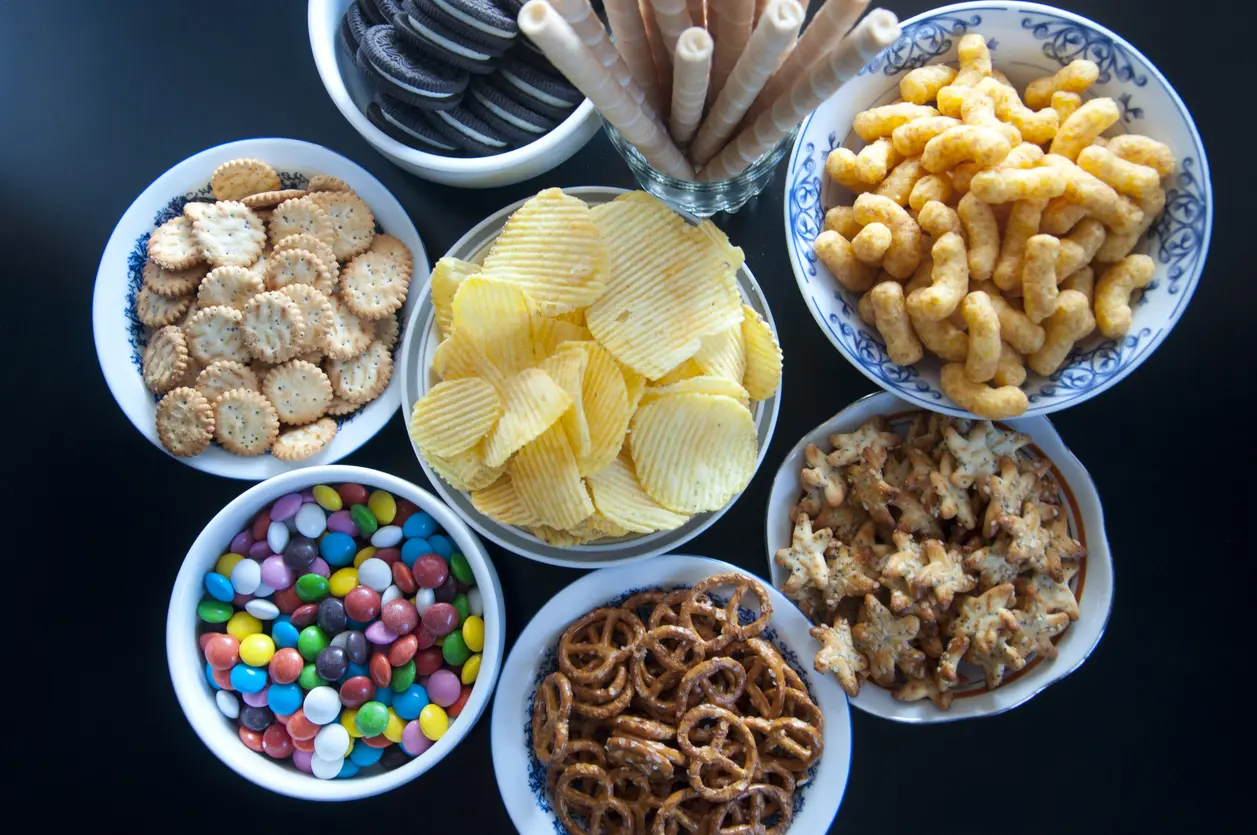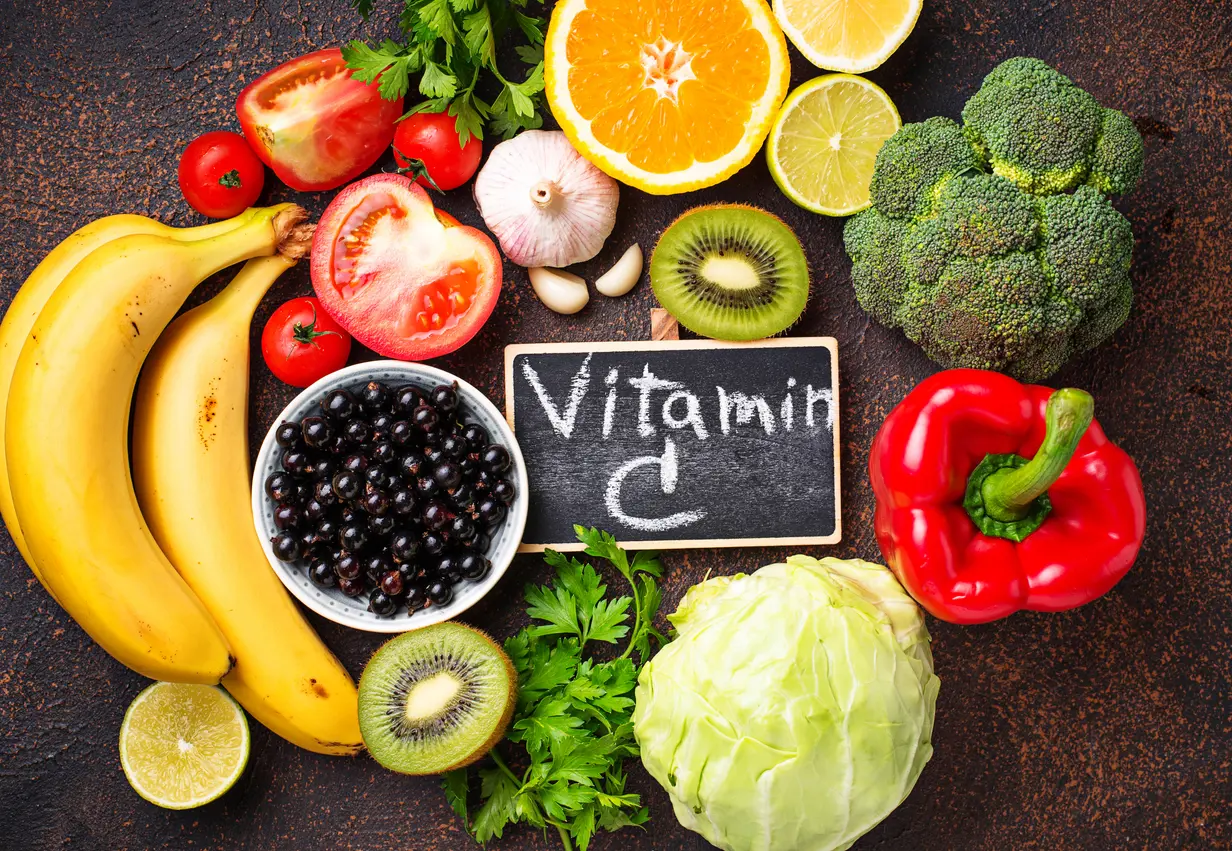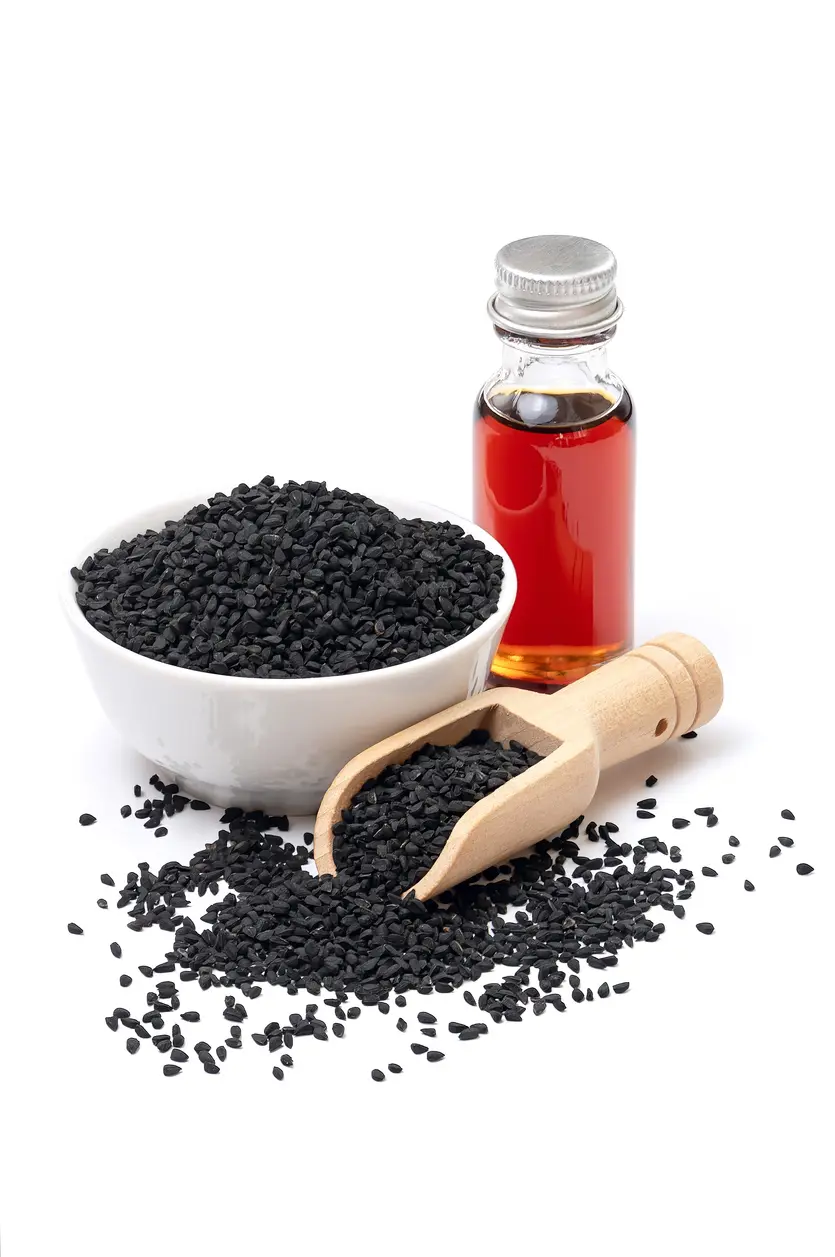Easy-to-Pack and Nutritious School Lunch Ideas
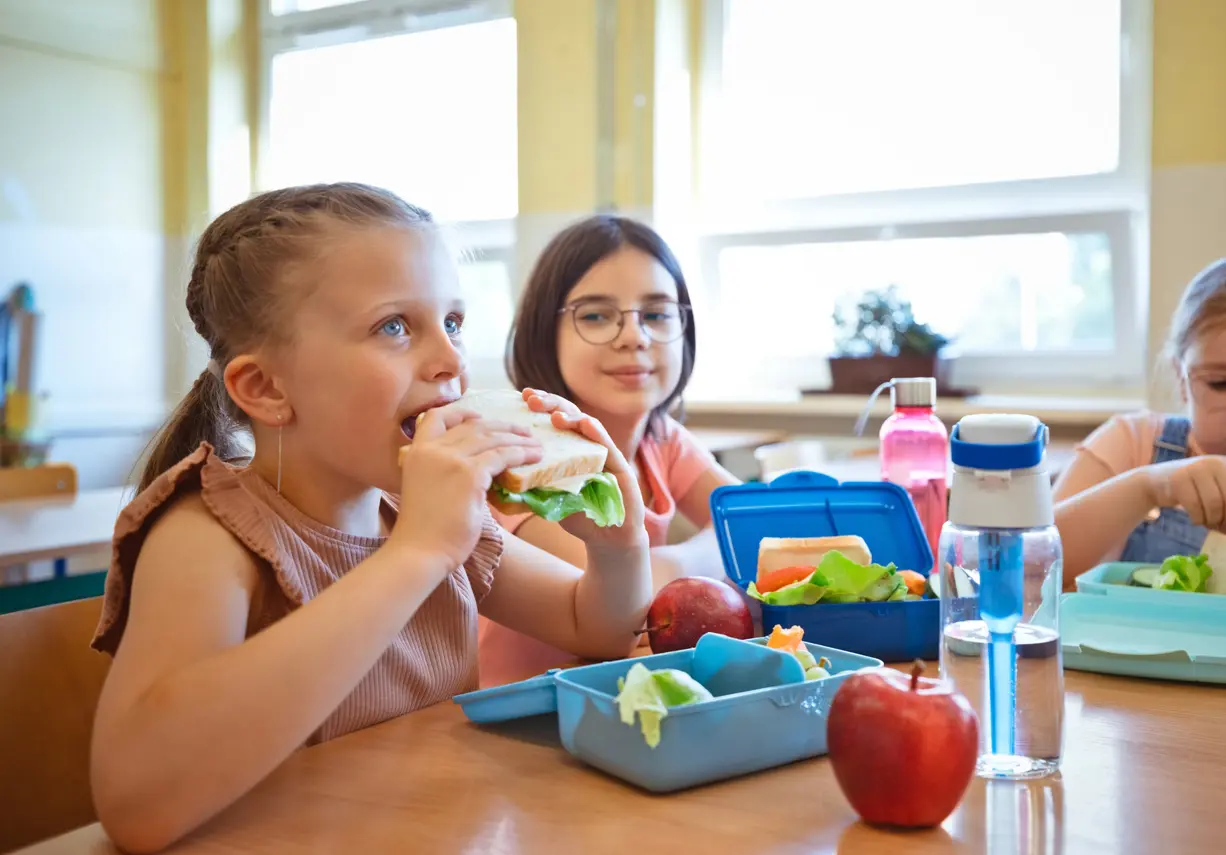
Nutritious meals are essential for a child’s energy, focus, and overall health. With children consuming anywhere from 30-40% of their total daily calories at lunch, packing a healthy school lunch is a prime opportunity to offer balanced nutrition. [1] Au LE et al. Eating School Meals Daily Is Associated with Healthier Dietary Intakes: The Healthy Communities Study. J Acad Nutr Diet. 2018;118(8):1474-1481.e1. doi:10.1016/j.jand.2018.01.010
However, finding healthy school lunch ideas that are both easy and tasty for children is a real challenge for parents, caregivers, and educators. I know this not only as a dietitian who works with families, but as a parent. If you’re struggling in the search for healthy kids' lunch ideas, not to worry, because there is something out there for everyone.
This guide offers practical, nutritious, and fun ideas for school lunches—no fancy preparation or exotic ingredients required. We’ll equip you with the essentials on making a balanced school lunch, share 20 easy ideas, and expert tips to manage even the pickiest of school-aged eaters.
What Makes a Healthy School Lunch?
A healthy school lunch should include several key components to cover all the nutritional foundations. Here is a go-to checklist to use when it’s time to prep your child’s lunch.
- Lean protein - chicken, fish, tofu, eggs, yogurt, cheese, beans/lentils
- Whole grains - whole wheat bread or tortillas, brown rice, whole grain crackers
- Fruits and vegetables - baby carrots, cucumbers, peppers, apples, bananas, clementines
- Healthy fats - nut or sunflower butters, tuna, salmon, avocados, seeds
- Hydration - low-sugar beverages like water, seltzer, 100% no-sugar-added juice
While all of these ingredients are important, even aiming for a minimum of three to start is a win.
Determining portion sizes
It’s helpful not only to know what your child should eat, but also to understand the proper portion sizes. Here are suggested portion sizes based on children ages 5-12. Please know these are just estimates, and your child’s individual growth and development, age, appetite, and activity level will dictate the exact amounts for your child. [2] American Academy of Pediatrics. Portions and Serving Sizes. HealthyChildren.org. Published August 17, 2015.
| Food Group | Portion Size (Per Meal) | Examples |
|---|---|---|
| Vegetables | ½–1 cup | Carrot sticks, salad, broccoli |
| Fruits | ½ cup | Apple slices, banana halves, berries |
| Whole Grains | ½–1 slice or ¼–½ cup | Whole grain bread, brown rice, whole grain pasta |
| Protein | 1-2 oz | Chicken, tofu, eggs, beans |
| Dairy | ½–1 cup or 1 slice | Milk, yogurt, cheese |
| Healthy Fats | 1–2 teaspoons | Nut butter, olive oil, avocado |
A note on variety and color
When planning a healthy school lunch, ensure there is sufficient variety and a range of colors throughout. Doing this ensures that a wide array of nutrients is represented, supporting your child’s optimal growth and development. This can mean a brightly colored vegetable, such as red bell peppers, a dazzling orange, or a rotation of different proteins every few days to keep things interesting.
Dietitian tip: When possible, avoid adding ultra-processed foods and snacks to your school lunches, such as those high in sodium, fat, and added sugar. These options typically offer little in terms of nutritional value and can increase the risk of obesity and other health problems in children.
21 Easy-to-Pack and Nutritious School Lunch Ideas
From bento boxes to hot lunches to vegetarian-friendly options, these healthy school lunch ideas cover all the nutritional bases.
Bento Box Combos
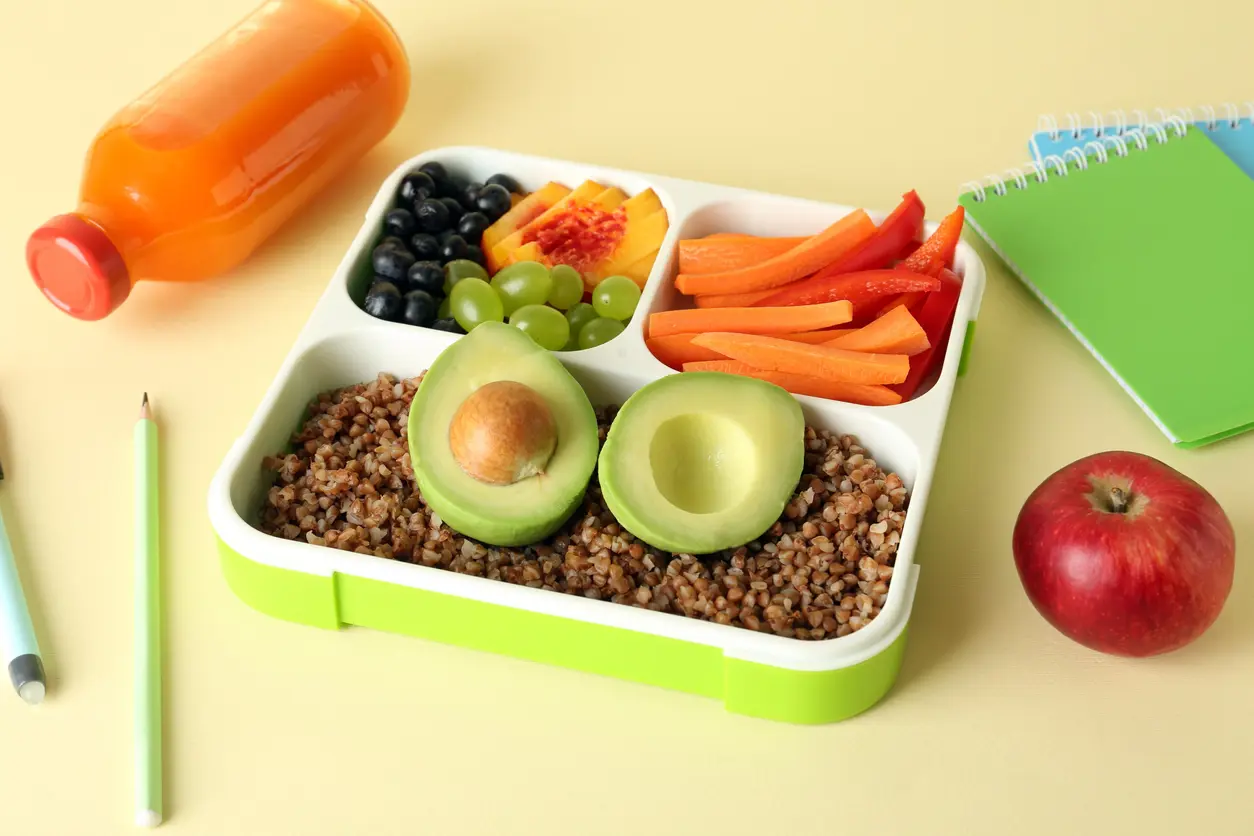
Bento box lunches are a super convenient school lunch idea that can be made in a matter of minutes. Simply combine a protein, a vegetable, a fruit, and a healthy carb, and you’re good to go.
1. Turkey and cheese roll-ups + cucumber slices + grapes + hummus + crackers
- Roll 1-2 slices of turkey and cheese together and arrange other ingredients in each individual bento box compartment.
2. Mini meatballs + cherry tomatoes + mozzarella balls + apple slices
- Warm up 2-3 mini turkey or beef meatballs and include them alongside other ingredients in your box.
3. Hard-boiled eggs + edamame + berries + whole wheat pita
- Add 1-1.5 eggs alongside other bento box ingredients. You can pre-make a dozen hard-boiled eggs for the week, or even better, buy them pre-made at most major grocery stores!
4. Whole wheat pasta salad + cherry tomatoes + clementine segments + mini granola bar
- Scoop ¼ cup of whole wheat pasta salad mixed with veggies and shredded chicken, filling the remaining compartments with the other ingredients.
Sandwich & Wrap Ideas
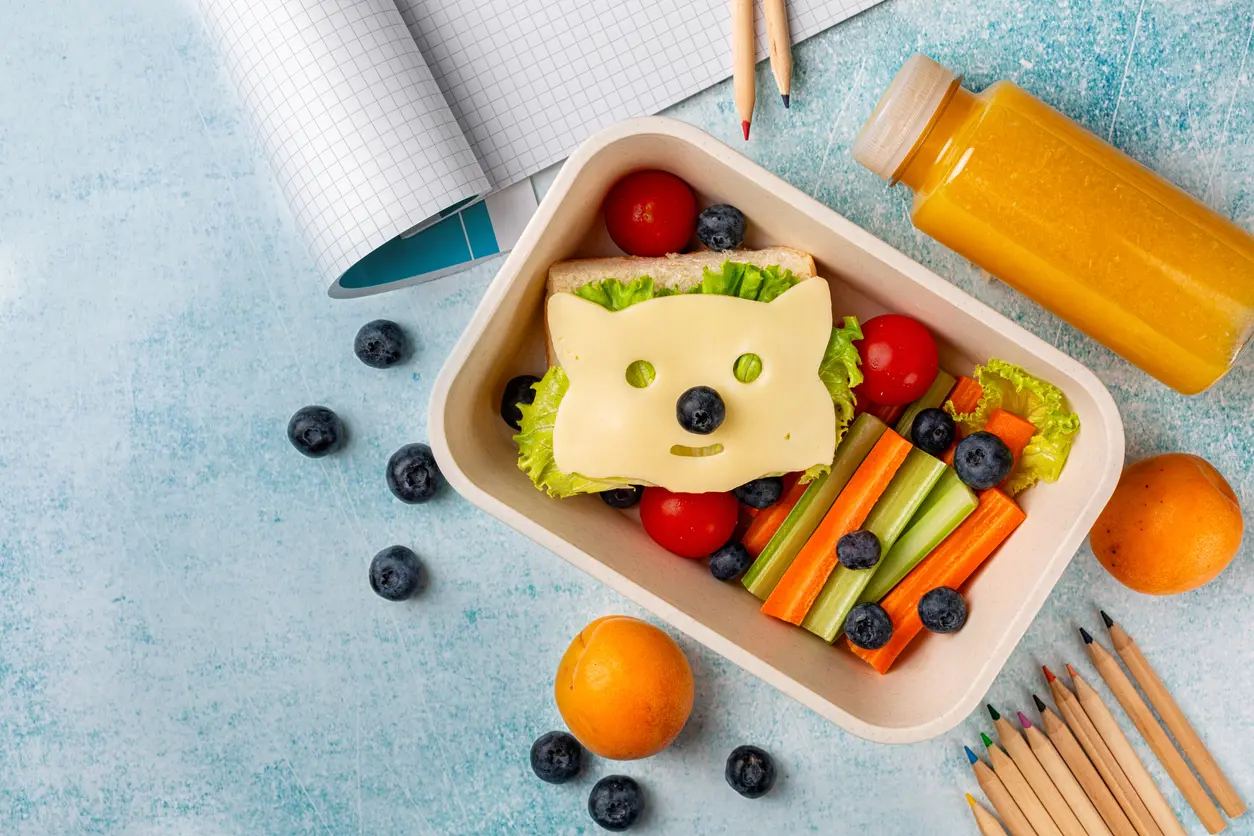
If a simple sandwich or wrap is easier to wrap your head around, try these incredibly simple yet nutritious options.
5. Whole wheat turkey and avocado wrap
- Add 1-2 slices of turkey deli meat and 1-2 tbsp avocado on whole wheat bread or a wrap.
6. PB & banana sandwich (sunflower seed butter for nut-free schools)
- Add 1-2 tbsp of peanut, almond, or nut-free butter to ½ a cut-up banana on whole wheat bread or a wrap. Bonus - since this is a non-perishable meal, no ice pack is needed!
7. Egg salad sandwich on whole grain bread
- Add 1-2 tbsp of egg salad onto a sandwich.
8. Chicken Caesar wrap with lettuce
- Scoop 1-2 tbsp of chicken breast, parmesan cheese, and lettuce onto a wrap for a protein-rich lunch.
9. Ham and cheese spinach wrap
- Add 2 slices of low-sodium ham, 1 slice cheese, shredded lettuce, and cucumber to a spinach wrap. Roll tightly or slice into pinwheels for easier eating.
DIY Lunchables & Snack Plates
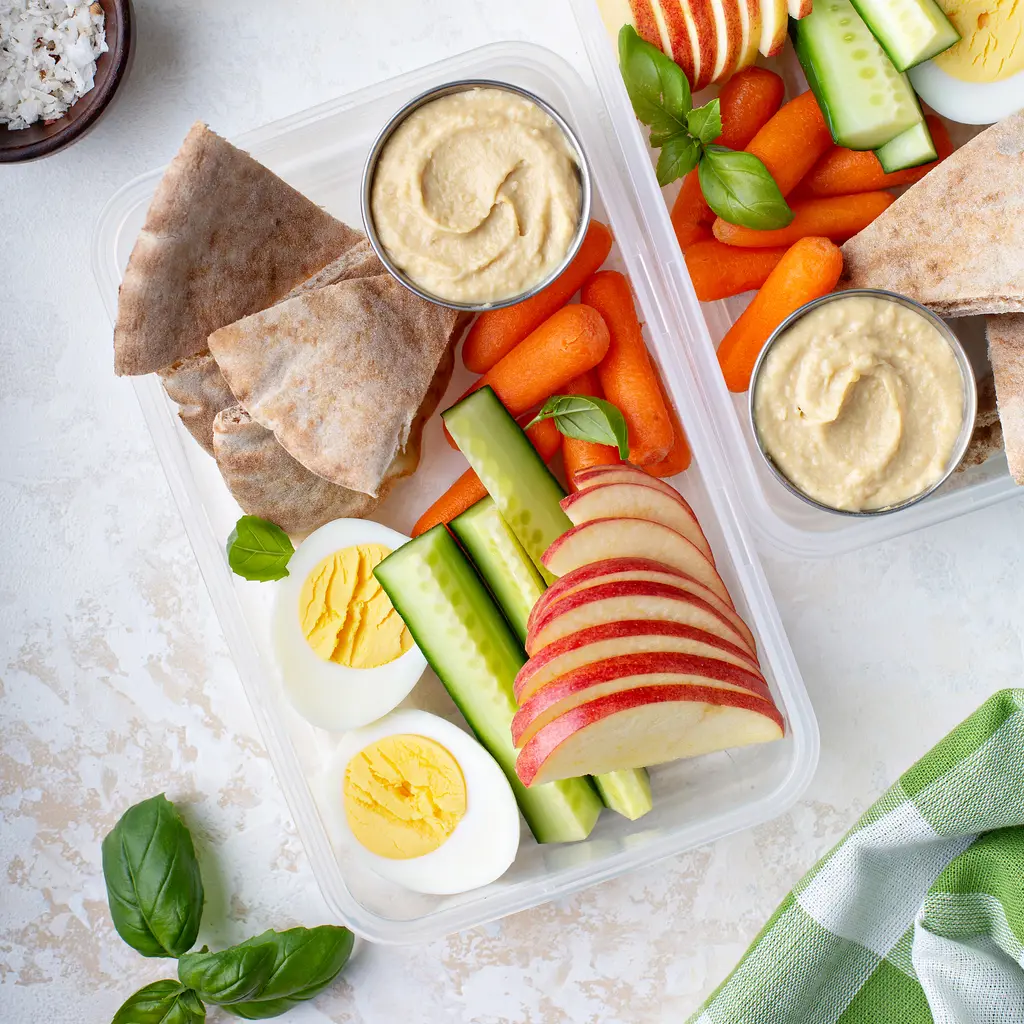
Most children won’t say no to a good lunchable. If your child is anything like mine, they’ll love one (or all) of these DIY lunchables and snack plate options.
10. Mini pita bread + hummus + baby carrots + hard-boiled eggs
- Lay out 2-3 mini whole wheat pita slices, 1-2 tbsp hummus, carrots & 1 hard-boiled egg for extra protein and sustenance.
11. Crackers + cubed cheese + deli meat + carrot sticks
- Add these ingredients to a sectioned lunchbox or bento box for a personalized lunchable experience.
12. Mini pancakes + almond butter + blueberries
- Substitute sunflower butter for allergies or for nut-free schools
13. Greek yogurt + granola + sliced peaches
- Portion out ½-1 cup low-sugar yogurt with a handful of granola and sliced peaches on the side. Have your child top their yogurt during lunchtime so the ingredients stay nice and crunchy!
Thermos-Friendly Hot Lunches
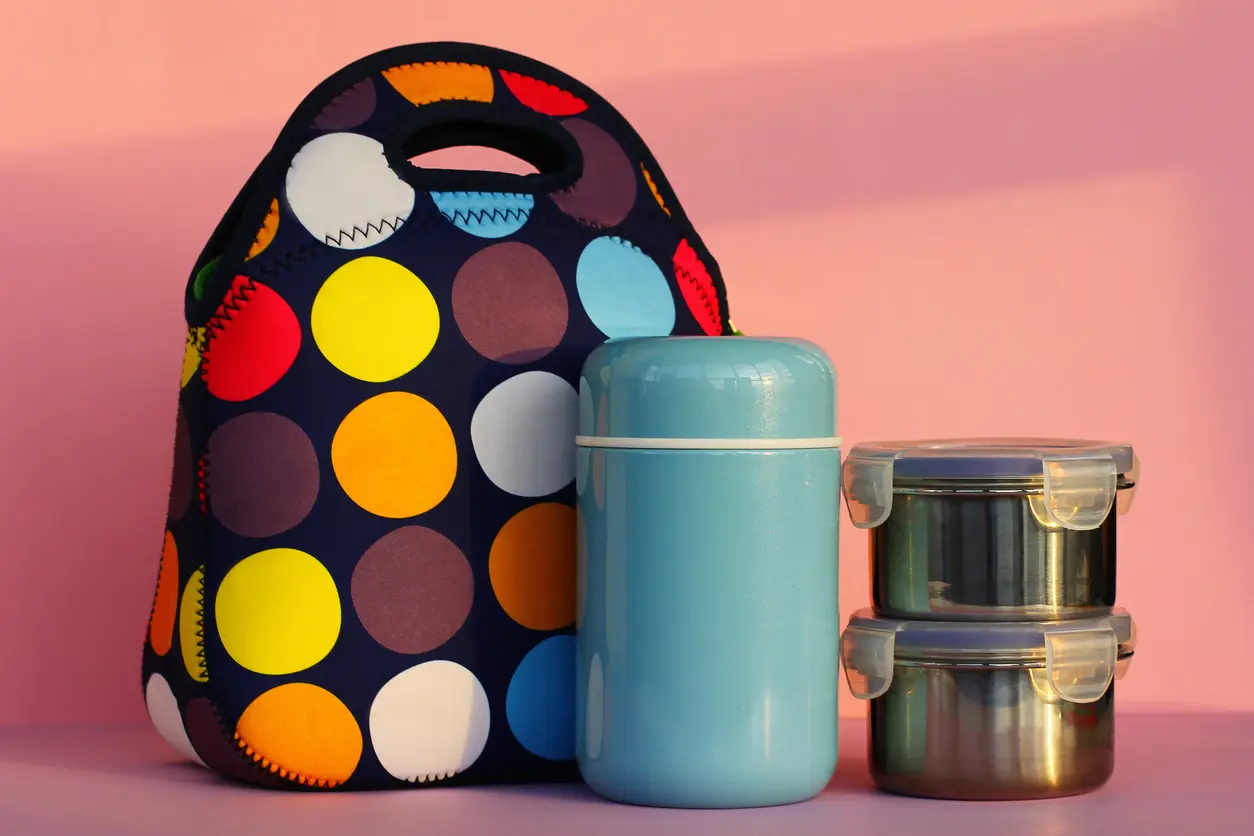
For children who prefer a hot meal, there are several easy options that stay fresh until lunchtime. For best results, use an insulated thermos that keeps food hot for at least 4 hours.
14. Turkey taco chili
Mix low-sodium canned turkey chili with black beans and corn for added fiber, top with shredded cheddar cheese, and add a handful of whole-grain tortilla chips on the side for a healthy, crunchy treat.
15. Mac and cheese with peas
Add ½ cup of mac and cheese with a ½ cup of frozen peas mixed in. This can be prepared in just a matter of minutes, and the addition of peas provides extra fiber and a crunch that kids will love.
16. Chicken and veggie stir-fry with brown rice
Add 1-2 oz of frozen or freshly cooked chicken, their favorite frozen veggies, and instant brown rice to a thermos. Mix together, add a sprinkle of low-sodium soy sauce, and watch your child light up with delight.
17. Lentil soup or tomato soup with grilled cheese dippers
Fill an insulated thermos with ½ cup of soup. Add grilled cheese sliced into “dippers” or “strips” on the side to dip into the warm soup⸺a winning combination!
Vegetarian/Vegan Options
If your child follows a vegetarian diet or you’re trying to increase their intake of plant foods, try these kid-friendly vegan options.
18. Edamame stir-fry
Mix frozen edamame, ¼ cup brown rice, frozen stir-fry veggies, & low-sodium soy sauce for a super-fast vegan-friendly stir-fry.
19. Hummus and veggie wrap
Spread 1-2 tbsp of hummus along with your child’s favorite veggies like white beans, chickpeas, cucumber, spinach, or tomatoes on a whole wheat wrap. A perfect blend of fiber and plant-based protein to satisfy childlike appetites.
20. Tofu nuggets + apples + quinoa salad
- While tofu may be a “scary” food for some children, it’s all about the way it is served. Tofu nuggets are a kid-friendly way to introduce this plant-based protein to children, and they simply involve dipping them in eggs, then coating them with panko breadcrumbs or cornstarch, and sautéing for a couple of minutes in a pan to create bite-sized nuggets.
- Pro tip - use extra-firm tofu and drain out excess water with paper towels before sautéing for the crispiest results.
21. Chickpea salad sandwich
- Add mashed canned chickpeas onto a wrap or whole wheat bread for a fiber-filled sandwich for healthy children’s digestion!
Make-Ahead Tips for Busy Mornings
Packing school lunches every day can sometimes feel like a chore on your already jam-packed mornings. Here are some hacks I’ve personally used to make my life easier, which I also recommend to my clients.
Prep ingredients on weekends:
Wash and chop fruits and veggies, portion out snacks, and cook staples like hard-boiled eggs or chicken salad in advance. Store everything in easy-to-grab containers, so all you have to do is scoop out what you need during the week.
Create a Weekly Menu:
Daily decision fatigue is real, so make it easier on yourself by planning once for the whole week. Plan 3–5 lunch combinations for the week to help streamline grocery shopping and rotate favorites to keep things interesting.
Don’t forget to include your child in the decision-making process!
Create a Lunch Station:
Once you have created your weekly lunch menu, arrange a lunch-packing zone in your fridge or pantry with ready-to-go options, such as yogurts, cut-up veggies, string cheese, and whole-grain crackers. This makes assembling lunches quick and pain-free.
Pack the Night Before:
Avoid the morning scramble by packing lunches right after you finish dinner. This can make prepping easier when you are already in this mode and in the kitchen. I spend just five minutes every night figuring out what I’m making for my kids’ lunches.
Then, I lay out the ingredients so there is one less thing to worry about in the morning. Leave shelf-stable items in lunchboxes ready to go, and place cold items front and center in the fridge to add in the morning.
Smart Tips for Packing School Lunches
Try these additional strategies to make things even more seamless and increase the appeal of your child’s school lunches.
Use an insulated lunchbox and ice packs:
This keeps your child’s lunch at the right temperature, preserving its taste and freshness.
Keep wet and dry items separate to avoid sogginess:
Store beverages away from solid food in case of spills or mishaps.
Use silicone muffin cups for portioning and variety:
This can be especially helpful if your child doesn’t like their food touching, as it helps keep individual food items separate.
Label items clearly for picky eaters or those with allergies:
Use sticky labels to identify each food item. This can be especially helpful for those with allergies or picky eaters who want to be one-hundred percent sure of what they are about to eat.
Get kids involved in choosing or packing:
This is probably one of the most influential things you can do to get your child excited about their school lunch. Simply enlisting their involvement in the decision-making process empowers them and prevents any surprises when they open their lunchbox at school.
This has been a game-changer in our house, where every night, our boys now get excited to choose their food group “essentials” for their lunchbox.
Addressing Picky Eaters
If you have a particularly picky eater on your hands, you may be wondering if these tactics will work for them. Here are a few stress-free tips that have worked for my own family of picky eaters and for my clients.
Offer variety and allow choices within healthy options:
Instead of just picking one healthy option for your child, open them up to 3-4 options for each food group. Allowing them more choices makes them feel they have more flexibility, enabling them to narrow down the decision based on what you are offering them. I’ve found that when I offer my boys the option of “a, b, or c” (all of which are healthy options), they love having the autonomy to make their pick.
Introduce new foods gradually alongside familiar favorites:
When introducing new nutritious foods, offer them in small quantities alongside food they already eat. This can be helpful and reduce the fear and pressure that may come from trying new foods. This can help because they see the “safe” food they are used to eating alongside it. Keep doing this, and you’ll be amazed at how it can naturally open up more options for your child.
Use fun shapes or colorful bento presentations:
We all eat with our eyes, including children. Because of this, arranging your child’s food into fun shapes like stars and hearts, or a variety of colors, can increase the chances of them trying them. When the food looks more visually appealing, your child may be more inclined to at least touch or try a bite of it (which is a great start!).
Keep trying—taste buds don’t change overnight, but they evolve with time. Don’t give up and stay consistent with offering a variety of healthy foods, even if your child doesn’t initially touch them.
Dietitian tip:
If you are serving the same food for a few days and they still refuse to try it, consider taking a break and offering it again in a few weeks. Just because they’re not eating a certain meal initially doesn’t mean they never will. The best you can do is keep going and try to let go of the pressure. [3] Wahome C. What to Know About Your Taste Buds. WebMD. Published April 21, 2022.
Foods to Limit or Avoid in School Lunches
To maintain a healthy school lunch, try to limit the addition of these foods and drinks as much as possible.
- Sugary drinks (sodas, juice boxes with added sugar)
- Overly salty packaged snacks (chips, flavored crackers)
- Candy and sweets
- Foods that spoil quickly (unless kept cold)
Many of these foods are high in added sugar and salt, which can have a negative impact on children’s health. [4] Masztalerz-Kozubek D et al. The Use of Added Salt and Sugar in the Diet of Polish and Austrian Toddlers. Associated Factors and Dietary Patterns, Feeding and Maternal Practices. Int J Environ Res Public Health. 2020;17(14):5025. Published 2020 Jul 13. doi:10.3390/ijerph17145025 Foods that spoil quickly if not kept cold include pre-cut, water-filled vegetables and fruits, such as cucumbers or strawberries, as well as meats like chicken and tuna.
When packing these perishable items, be sure to store them in an insulated bag with an ice pack to maintain their freshness.
Conclusion
Healthy school lunches don’t have to be complicated or time-consuming—they just need to be balanced, approachable, and tailored to the child’s preferences. By focusing on variety, including at least three food groups, and getting kids involved in the process, you can create meals that are both nutritious and enjoyable.
Remember that consistency is more important than perfection. Know that even small changes can have a big impact on a child’s energy, focus, and long-term health.
Was this article helpful?
-
Eating School Meals Daily Is Associated with Healthier Dietary Intakes: The Healthy Communities Study. J Acad Nutr Diet. 2018;118(8):1474-1481.e1. doi:10.1016/j.jand.2018.01.010; Au LE et al. ;
https://pubmed.ncbi.nlm.nih.gov/29555435/ -
American Academy of Pediatrics. Portions and Serving Sizes. HealthyChildren.org. Published August 17, 2015. ;
https://www.healthychildren.org/English/healthy-living/nutrition/Pages/Portions-and-Serving-Sizes.aspx -
What to Know About Your Taste Buds. WebMD. Published April 21, 2022.; Wahome C. ;
https://www.webmd.com/diet/what-to-know-about-taste-buds -
The Use of Added Salt and Sugar in the Diet of Polish and Austrian Toddlers. Associated Factors and Dietary Patterns, Feeding and Maternal Practices. Int J Environ Res Public Health. 2020;17(14):5025. Published 2020 Jul 13. doi:10.3390/ijerph17145025; Masztalerz-Kozubek D et al. ;
https://pubmed.ncbi.nlm.nih.gov/32668675/




